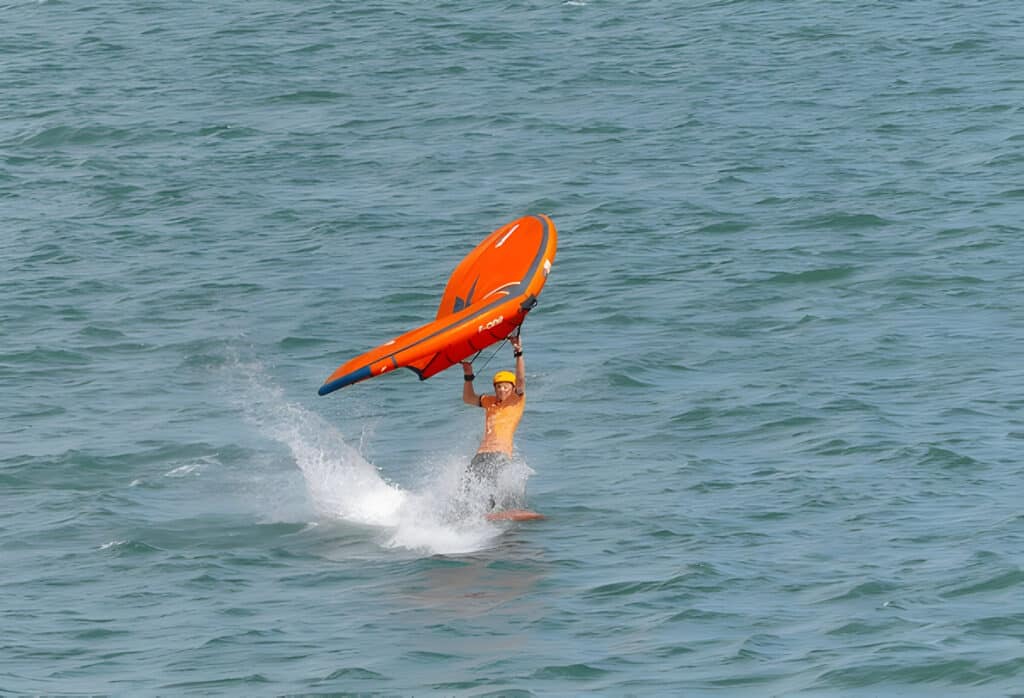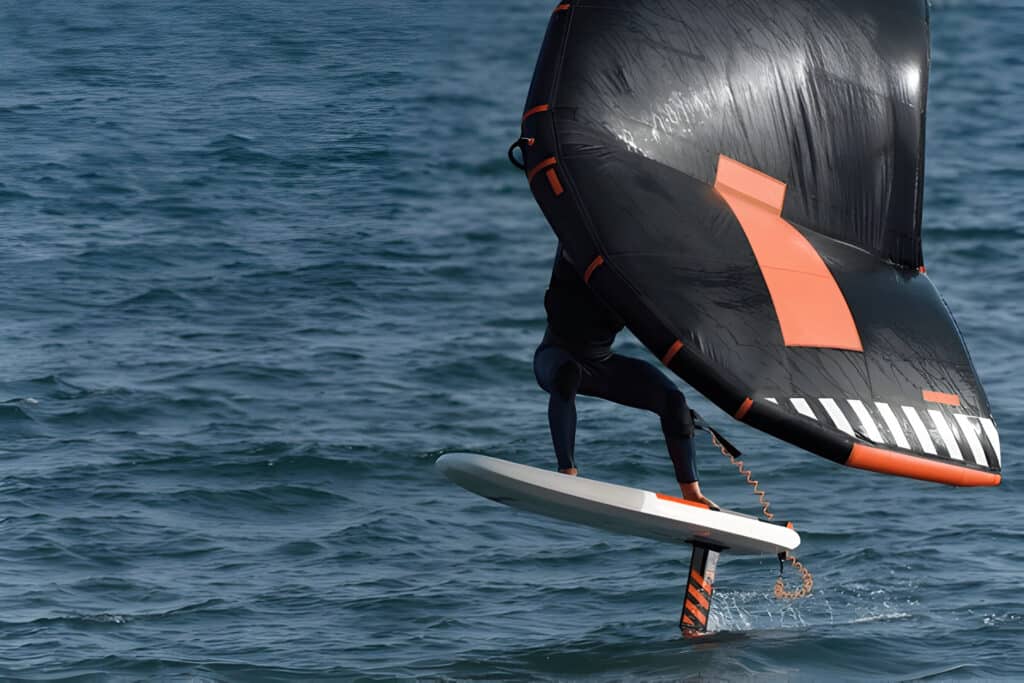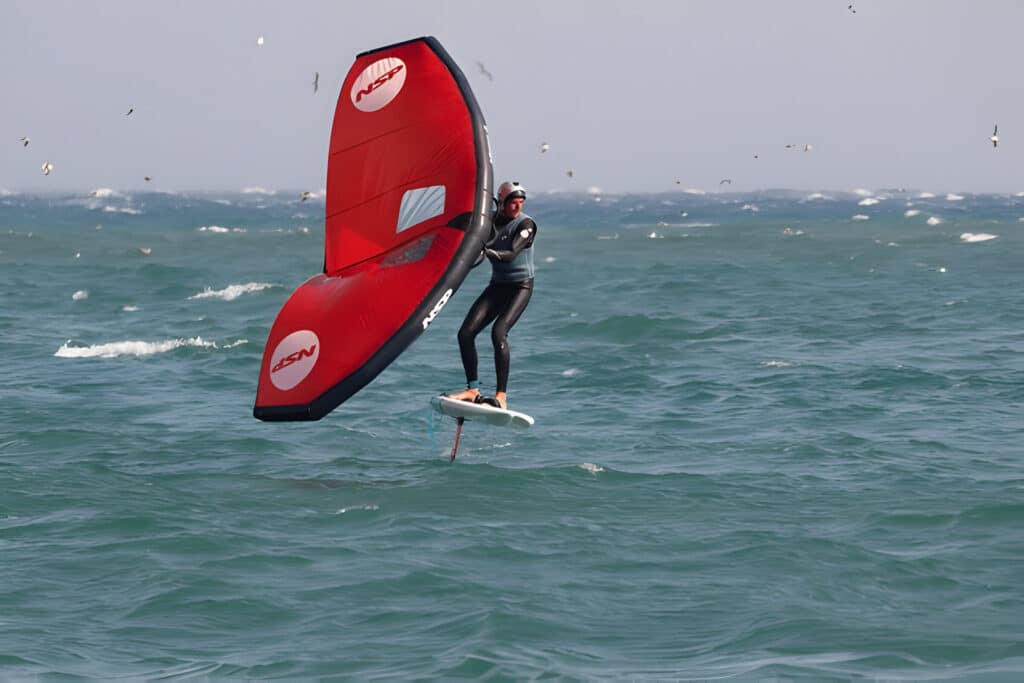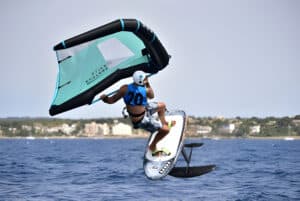Wing foiling is indeed an excellent form of exercise that offers a full-body workout while providing an exhilarating water sports experience. This relatively new sport combines elements of windsurfing, kiteboarding, and surfing, engaging multiple muscle groups and improving overall fitness.
The dynamic nature of wing foiling challenges your balance, core strength, and cardiovascular endurance simultaneously. As you maneuver the wing and control the board, you’ll be working your arms, shoulders, back, and leg muscles, making it a comprehensive exercise routine.
In this article, we’ll explore the specific benefits of wing foiling. Whether you’re a seasoned water sports enthusiast or a beginner looking for a new way to stay active, wing foiling offers a unique and effective workout option.

Physical Benefits of Wing Foiling
Full-Body Workout Engaging Multiple Muscle Groups
Wing foiling provides an exceptional full-body workout that engages multiple muscle groups simultaneously. This dynamic exercise combines elements of windsurfing, kitesurfing, and foil boarding, resulting in a comprehensive fitness regimen that targets various areas of the body.
The core muscles are heavily involved in wing foiling, as they work constantly to maintain balance and stability on the board. The abdominals, obliques, and lower back muscles are continuously engaged to keep the body upright and respond to changes in wind and water conditions. This constant activation helps strengthen the core, improving overall body stability and posture.
Leg muscles, particularly the quadriceps, hamstrings, and calves, are intensively worked during wing foiling sessions. These muscles are crucial for maintaining balance on the board and controlling its direction. The constant micro-adjustments required to stay upright on the foil board provide an excellent lower body workout, enhancing strength and endurance.
Upper body strength is also significantly developed through wing foiling. The arms, shoulders, and back muscles are engaged in controlling the wing and managing its power. Holding and maneuvering the inflatable wing against the wind provides resistance training for the upper body, similar to exercises with body weight. This aspect of wing foiling contributes to improved upper body strength and muscular endurance.
Improves Cardiovascular Fitness and Endurance
During a wing foiling session, participants experience sustained periods of moderate to high-intensity activity. The constant maneuvering, balancing, and propulsion required in wing foiling elevate the heart rate, promoting cardiovascular health. A typical hour-long wing session can burn between 300-600 calories.
The intermittent nature of wing foiling, with periods of intense effort followed by brief recovery, mimics high-intensity interval training (HIIT). This type of exercise has been shown to improve VO2 max, a key indicator of cardiovascular fitness. A study published in the Journal of Sports Science & Medicine found that water sports like windsurfing, which shares similarities with wing foiling, can increase VO2 max by up to 7% after regular practice.

Low-Impact Nature Is Easier on Joints Compared to High-Impact Sports
The water’s buoyancy provides natural support for the body, alleviating pressure on weight-bearing joints such as knees, hips, and ankles. This makes wing foiling particularly beneficial for individuals with joint issues or those recovering from injuries. The smooth, gliding motion of foiling across the water surface further contributes to its low-impact nature, as there are no sudden impacts or jarring movements typically associated with land-based sports.
Wing foiling engages the entire body in a fluid, continuous motion, distributing the workload across multiple muscle groups. This balanced approach to exercise helps prevent overuse injuries that can occur when repetitive stress is placed on specific joints or muscles. The core muscles, in particular, are constantly engaged to maintain balance and control, providing a stable foundation for the body’s movements without putting excessive strain on any single joint.
Enhances Balance, Coordination, and Proprioception
Balance is a crucial component of wing foiling, as riders must maintain their equilibrium on a board while managing the wing and navigating wind and water conditions. This constant need for adjustment engages the core muscles, leg muscles, and Cervical muscles, promoting better overall body awareness and stability.
Coordination is heavily emphasized in wing foiling, as it requires the simultaneous management of multiple body movements. Riders must coordinate their arms to control the wing, legs to steer the board, and core to maintain posture. This multi-tasking aspect of wing foiling enhances neuromuscular coordination, which can be beneficial in various other sports and daily activities.
Proprioception, the body’s ability to sense its position in space, is greatly improved through wing foiling. The constant feedback from the board, wing, and water helps develop a heightened sense of body awareness. This improved proprioception can lead to better reaction times, reduced risk of injury, and enhanced overall physical performance.

Mental Health Benefits of Wing Foiling
Provides a Meditative and Mind-Clearing Experience
When engaging in wing foiling, individuals must maintain a high level of concentration to balance on the board, control the wing, and navigate the water. This intense focus on the present moment naturally pushes away distracting thoughts and worries, allowing the mind to enter a state of flow. The repetitive motions of handling the wing and adjusting body movements can become almost automatic, similar to the rhythmic breathing in meditation practices.
The natural setting of wing foiling also contributes to its meditative qualities. Being out on the water, surrounded by the elements, can have a calming effect on the mind. The sound of the wind, the feeling of the water beneath the board, and the vastness of the horizon all work together to create a sensory experience that can be both grounding and liberating.
Moreover, wing foiling often requires adapting to changing wind conditions and water patterns, which cultivates a sense of mindfulness and present-moment awareness. This constant adjustment and attunement to one’s environment can help develop a deeper connection with nature and oneself, further enhancing the meditative aspect of the sport.
For many wing foilers, a single hour-long wing session can provide the same mental clarity and stress relief as traditional meditation practices. The physical exertion combined with the mental focus required in wing foiling can lead to a release of endorphins, promoting a sense of well-being and euphoria often referred to as a “runner’s high” in other endurance sports.
Boosts Mood and Reduces Stress through Exercise and Time in Nature
Spending time in nature, particularly near water, has been scientifically proven to reduce stress and anxiety. A study published in the Journal of Environmental Psychology found that exposure to natural environments led to lower levels of cortisol, the stress hormone, in participants. Wing foiling provides an ideal opportunity to immerse oneself in nature, whether on a calm lake or riding ocean waves.
The combination of physical activity and nature exposure in wing foiling can lead to improved mental health outcomes. A meta-analysis published in Frontiers in Psychology revealed that exercising in natural environments resulted in greater reductions in tension, confusion, anger, and depression compared to indoor exercise. This suggests that wing foiling may offer enhanced mood-boosting benefits compared to gym-based workouts.
Wing foiling also promotes mindfulness and present-moment awareness. The level of concentration required to balance on the board, control the wing, and navigate changing wind conditions naturally draws the mind away from daily stressors and into the present moment. This meditative aspect of the sport can contribute to reduced anxiety and improved overall mental well-being.

Builds Self-Confidence and Resilience
The process of learning wing foiling requires persistence and dedication. Beginners often face gusty winds and difficult launch spots, which can be intimidating at first. However, as they master the techniques of handling the inflatable wing and navigating the board, their confidence grows exponentially. Each successful session reinforces their belief in their abilities, creating a positive feedback loop that extends beyond the water.
Overcoming the initial learning curve of wing foiling develops problem-solving skills and adaptability. Riders must constantly adjust their body movements and wing control in response to changing wind conditions and water surfaces. This dynamic exercise in decision-making and quick thinking translates into increased confidence in other areas of life, as wing foilers learn to trust their judgment and abilities.
The exhilaration of wing foiling also pushes individuals out of their comfort zones. Tackling new spots or attempting more advanced maneuvers requires courage and a willingness to take calculated risks. As wing foilers progress, they develop a growth mindset, understanding that setbacks are part of the learning process and not a reflection of their worth or capabilities.
Conclusion
Wing foiling emerges as an excellent form of exercise, offering a unique blend of physical and mental health benefits. This exhilarating water sport provides a full-body workout that engages multiple muscle groups, improves cardiovascular fitness, and enhances balance and coordination. Its low-impact nature makes it an ideal choice for those seeking a joint-friendly alternative to high-impact sports. Beyond the physical advantages, wing foiling delivers significant mental health benefits, serving as a meditative experience that clears the mind, reduces stress, and boosts self-confidence. As an activity that combines exercise with time in nature, wing foiling proves to be an effective way to maintain a healthy weight, improve overall well-being, and cultivate resilience. Whether you’re a fitness enthusiast or someone looking for a new, exciting way to stay active, wing foiling offers a comprehensive approach to exercise that nourishes both body and mind.


